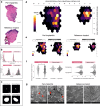Titanium micro-particles are commonly found in soft tissues surrounding dental implants
- PMID: 40102654
- PMCID: PMC11920262
- DOI: 10.1038/s43856-025-00756-3
Titanium micro-particles are commonly found in soft tissues surrounding dental implants
Abstract
Background: Dental implants are one of the most frequently used medical devices for therapeutic purposes in dentistry. Peri-implantitis is a severe, microbial biofilm-associated condition, characterized by inflammation in peri-implant soft tissues and destruction of supporting bone. It has been suggested that metal particles originating from the implant may influence the local host response to microbial biofilms.
Methods: Soft tissue biopsies were collected from implant sites with and without peri-implantitis in 21 patients. Micro Proton-induced X-ray Emission (µ-PIXE) analysis was used to localize, quantify and characterize titanium micro-particles within tissues. RNA sequencing was performed to evaluate potential associations between titanium micro-particles and gene expression profiles in peri-implantitis lesions.
Results: Titanium micro-particles are consistent findings in soft tissues surrounding dental implants. Their occurrence varies across patients but not between sites with and without peri-implantitis within the same individual. Most particles reside in a 2-mm wide tissue portion close to the implant/tissue interface. The time in function of the implants does not influence the volumetric density of titanium micro-particles, while implant systems do. Fourteen differentially expressed genes are identified when comparing peri-implantitis samples with high and low densities of titanium micro-particles. The gene-set enrichment analysis reveals functions related to the regulation of the immune response and epithelial development.
Conclusions: The present results indicate that titanium micro-particles are commonly found in tissues surrounding dental implants and are not associated with the occurrence of peri-implantitis.
Plain language summary
Dental implants are frequently used in dentistry. Peri-implantitis is a severe condition in which micro-organisms such as bacteria grow excessively and cause inflammation in areas around the implants. This can result in destruction of supporting bone. It has been suggested that metal particles originating from the implant may influence how the body reacts to the presence of the bacteria. We analyzed samples of human soft tissue taken from implant sites with and without peri-implantitis. Titanium micro-particles were consistent findings in the soft tissue specimens regardless of the presence of peri-implantitis. The results indicate that titanium micro-particles are commonly found in tissues surrounding dental implants and are not associated with the occurrence of peri-implantitis.
© 2025. The Author(s).
Conflict of interest statement
Competing interests: T.B.: University institution grants: Dentsply Implants IH, Osteology Foundation; consulting fees and honoraria for lectures: Dentsply Implants IH; leadership or fiduciary role in other board, society, committee, or advocacy group: National Board of Health and Welfare, Sweden (National guidelines in Dentistry); Swedish Quality Registry for Caries and Periodontal Disease. J.D.: University institution grants: Eklund Foundation, Electro Medical Systems; honoraria for lectures: Osteology Foundation, Dentsply Sirona Implants, Straumann Group. C.T.: honoraria for lectures: Dentsply Sirona Implants, Straumann Group, Geistlich Pharma AG, Sweden & Martina. The other authors declare no competing interests.
Figures





Similar articles
-
Metal elements in tissue with dental peri-implantitis: a pilot study.Clin Oral Implants Res. 2016 Sep;27(9):1178-86. doi: 10.1111/clr.12718. Epub 2015 Oct 27. Clin Oral Implants Res. 2016. PMID: 26508041
-
Transcriptome-wide Gene Expression Analysis in Peri-implantitis Reveals Candidate Cellular Pathways.JDR Clin Trans Res. 2022 Oct;7(4):415-424. doi: 10.1177/23800844211045297. Epub 2021 Sep 28. JDR Clin Trans Res. 2022. PMID: 34583558 Free PMC article.
-
Exfoliative cytology and titanium dental implants: a pilot study.J Periodontol. 2013 Jan;84(1):78-83. doi: 10.1902/jop.2012.110757. Epub 2012 Mar 13. J Periodontol. 2013. PMID: 22414261
-
Titanium particles in peri-implantitis: distribution, pathogenesis and prospects.Int J Oral Sci. 2023 Nov 23;15(1):49. doi: 10.1038/s41368-023-00256-x. Int J Oral Sci. 2023. PMID: 37996420 Free PMC article. Review.
-
Is Metal Particle Release Associated with Peri-implant Bone Destruction? An Emerging Concept.J Dent Res. 2018 Mar;97(3):259-265. doi: 10.1177/0022034517740560. Epub 2017 Nov 12. J Dent Res. 2018. PMID: 29130804 Review.
References
-
- Regulation (EU) 2017/745 of the European Parliament and of the Council of 5 April 2017 on medical devices, amending Directive 2001/83/EC, Regulation (EC) No 178/2002 and Regulation (EC) No 1223/2009 and repealing Council Directives 90/385/EEC and 93/42/EEC (Text with EEA relevance).
-
- SKaPa Årsrapport 2022: Svenskt kvalitetregister för Karies och Parodontit (in Swedish). Karlstad: sjuhäradsbygdens Tryckeri AB; 2022. The Swedish Quality registry for Caries and Periodontal diseases. https://www.skapareg.se/other-language/ (2022).
-
- Berglundh, T. et al. Peri-implant diseases and conditions: consensus report of workgroup 4 of the 2017 World Workshop on the Classification of Periodontal and Peri-Implant Diseases and Conditions. J. Periodontol.89, S313–S318 (2018). - PubMed
-
- Schwarz, F., Derks, J., Monje, A. & Wang, H. L. Peri-implantitis. J. Periodontol. Jun.89, S267–S290 (2018). - PubMed
-
- Lang, N. P. & Berglundh, T. Working Group 4 of Seventh European Workshop on Periodontology. Periimplant diseases: where are we now? Consensus of the Seventh European Workshop on Periodontology. J. Clin. Periodontol.38, 178–181 (2011). - PubMed
LinkOut - more resources
Full Text Sources

